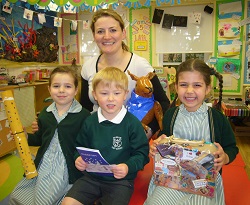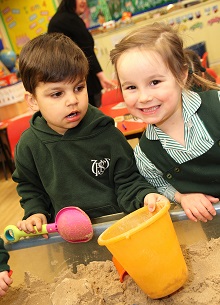Blue for boys – Pink for girls?
 Wilmslow Prep School, which will this year celebrate its 104th birthday, will be introducing boys to the school from September, initially into Kindergarten, Reception and Form 1. In subsequent years these boys will progress through the School until the whole School offers a mixed environment.
Wilmslow Prep School, which will this year celebrate its 104th birthday, will be introducing boys to the school from September, initially into Kindergarten, Reception and Form 1. In subsequent years these boys will progress through the School until the whole School offers a mixed environment.
Paul Reynolds, the headteacher, said, “More and more of our parents are asking us for a family proposition where their sons and daughters are educated under one roof, particularly as parents’ lives have become busier. We were keen to meet this demand but also keen to maintain single sex teaching and its proven benefits as children develop, as we believe this is a significant contributor to our exceptional results.”
With this in mind, the boys and girls will be taught separately for the key core subjects from Form 3 onwards, when their learning styles can become more markedly different and when the classroom environment becomes more formalised.
 Rebecca Milne, the Head of Early Years, agrees that there is a perception that boys learn differently than girls, but she believes that all young children benefit if they have the opportunity to learn ‘on the go.’ She says, “All our young pupils are encouraged to join in with formal learning, regardless of gender. Nevertheless, at this age, children do learn best through play and we continue to build activities around the needs and interests of all our children, boys and girls.”
Rebecca Milne, the Head of Early Years, agrees that there is a perception that boys learn differently than girls, but she believes that all young children benefit if they have the opportunity to learn ‘on the go.’ She says, “All our young pupils are encouraged to join in with formal learning, regardless of gender. Nevertheless, at this age, children do learn best through play and we continue to build activities around the needs and interests of all our children, boys and girls.”
These days schools don’t fall into the trap of having ‘girls-only’ or ‘boys-only’ toys or activities, so the staff at WPS haven’t found this to be an issue. Still the new environment did lead to some changes. Rebecca smiles, “What we are seeing now is that the girls are engaging more with toys such as the cars and garage since the arrival of boys. These toys have always been there, but watching how the boys play with them is definitely encouraging the girls to explore in more depth. Likewise, the boys watch the girls ‘cooking’ with the dough and they want to join in. This demonstrates the positive effect of a variety of different interactions on all the young pupils.”






